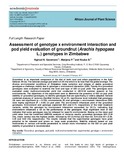Please use this identifier to cite or link to this item:
https://cris.library.msu.ac.zw//handle/11408/3028| Title: | Assessment of genotype x environment interaction and pod yield evaluation of groundnut (Arachis hypogaea L.) genotypes in Zimbabwe | Authors: | Ngirazi, N. Savemore Manjeru, Pepukai Ncube, B. |
Keywords: | Groundnut Genotypes Pod-yield Multi-environmental trial Eexperimental Genotype x environment interaction |
Issue Date: | 2017 | Publisher: | Academic Journals | Series/Report no.: | African Journal of Plant Science;Vol.11, No. 3; p. 54-60 | Abstract: | Groundnut is an important component of the diet of both rural and urban populations in the Sub-Saharan Africa. The national average pod yield is 0.25 t/ha which is far less than the global average. The diverse environmental conditions of Zimbabwe make selection and release of stable groundnut genotypes a challenge, mainly due to genotype x environment interaction (GEI). Twenty-five groundnut genotypes were evaluated to examine the level and type of GEI on pod yield. The genotypes were evaluated under multi-environmental yield trial conducted in (2013/14 summer season) at five environments. The objectives of the experiment were to determine the presence of GEI on pod yield stability of groundnut genotypes, to identify genotypes that are specifically or widely adapted. General combined analysis of variance (GenStat Version 14) at 5% significance level indicated that genotypes (G) were not significant (p = 0.153), environments (E) and genotype x environment interactions (GEI) were highly significant (P < 0.05) on pod yield. The environment influenced yield of the groundnut genotypes. Environment and genotype explained 58.8 and 6.1% respectively of the total treatment variance, whilst the genotype by environment interaction accounted for 35.1%, indicating that environment influenced a lot on the performance of the genotypes. High significant level of GEI indicates that some genotypes may be released for specific environments. Basing on the mean pod yield value from the combined (ANOVA) analysis of variance results, groundnut genotype G24 (3.34 t/ha, check variety) was the highest yielder, followed by G7 (3.31t/ha) and then G2, G14 and G11 (3.29, 3.25 and 3.02 t/ha respectively). The results indicate that the experimental genotypes have great potential to be released and grown on large scale production. Stability analysis based on one multivariate or various uni-variate parameters to extract more information on the GEI on pod yield stability of groundnut is recommended. | URI: | http://www.academicjournals.org/journal/AJPS/article-full-text/C44669E63323 http://hdl.handle.net/11408/3028 |
ISSN: | 1996-0824 |
| Appears in Collections: | Research Papers |
Files in This Item:
| File | Description | Size | Format | |
|---|---|---|---|---|
| Assessment of genotype.pdf | Full Text | 719.8 kB | Adobe PDF |  View/Open |
Page view(s)
142
checked on Dec 11, 2025
Download(s)
34
checked on Dec 11, 2025
Google ScholarTM
Check
Items in MSUIR are protected by copyright, with all rights reserved, unless otherwise indicated.



